Mother follows instincts to treatment for child
By Press And Journal Staff : 9/5/2007

It may have been “mothers’ intuition” or her experience as a medical worker, but Tara Woodman did her homework and took an active role in assuring that her son Makhi received the best possible attention to his mysterious condition.
Makhi was diagnosed with a rare disorder called opsoclonus-myoclonus syndrome (OMS) in July, after a scary and frustrating misdiagnosis. Following a viral infection two months earlier, the two-and-a-half-year-old’s condition didn’t improve according to their neurologist’s prognosis.
“I think it was my mothers’ instinct,” said Woodman. “I did what I had to do.”
Makhi’s story began the last week in April, just after Tara, a nursing assistant, and Adrian, an electrician, bought a home in Middletown. That week, Makhi had been hospitalized for three days with severe diarrhea from a Rotavirus infection. In the week after his release, he became clumsy and his hands shook and by May 2 he had to be rushed to his pediatrician’s office with uncontrollable shaking and eye rolling.
Makhi was first diagnosed with post-viral cerebellitis; a sudden onset of uncoordinated muscle movement following a viral infection. The condition usually resolves itself in four to six weeks. The Woodmans were referred to a neurologist who confirmed the pediatrician’s diagnosis. But on the way home that day, Makhi began vomiting and was back in the hospital for two more weeks.
Following his release, Makhi was not improving even after five weeks. He still couldn’t walk and shook when he even tried. Doctors extended his estimated recovery time from four to six weeks; Tara was told recovery would take to six to nine months.
“My gut told me there was something else wrong with our son,”she said. “I didn’t know what, but I knew that it was more than post-viral cerebellitis.”
So Tara sought a second opinion on July 12. The two common tests for neuroblastoma – a tumorous cancer of the nervous system – had come back negative months ago. But this time an MRI was ordered and a tumor was located on Makhi’s spine. It was surgically removed on July 23, but significant problems with his nervous system continued.
Tara immediately started researching OMS via the Internet. One Sunday night, she located the world’s only expert on the disease in Springfield, Ill., and on Monday morning called and made an appointment.
She then spent two days trying to get her insurance company to cover the visit. “They did, on Tuesday evening, so my husband and I packed the car and headed to Springfield to meet Dr. Pranzatelli Thursday morning,” said Tara.
Last week Makhi started chemotherapy. Makhi’s prognosis is good but his mother said, “He still needs a lot more time and attention than the average toddler.” Just keeping up with the demands of medical appointments for lab work, check-ups, and physical, occupational and speech therapy has kept both Mom and Grandma away from their jobs for more than a month.
Tara’s mother, Brenda Spigelmeyer, has been away from her home in Galeton, Pa., living with the Woodmans, lending a hand with cooking, cleaning, laundry, and driving kids to appointments and activities.
“We were always a very active family: playing soccer, going to playgrounds and swimming” said Tara.
Makhi’s outcome is likely to be better because Tara saved precious time in the diagnosis and treatment process. She did so by taking the initiative to get a second opinion and seek out information on her own. Tara advises parents faced with similar medical decisions, “Don’t ever ignore that [gut] feeling.”
What is OMS?
The number of known OMS cases worldwide is uncertain but it is estimated between 100 and 150. There is only one physician, Michael Pranzatelli, who is considered an OMS expert. Consequently, it is common for OMS to be misdiagnosed initially. This was the case when Makhi first exhibited the telltale “dancing-eyes-dancing-feet” symptoms on May 2. OMS can sometimes be a symptom of neuroblastoma; a tumorous cancer of the nerve network that carries messages to the brain.
Opsoclonus-myoclonus literally means “dancing eyes-dancing feet.” The uncontrolled eye and limb movements are a result of an attack on the nervous system. Often present at birth, the sudden growth of the neuroblastoma frequently follows a viral infection like the flu. The immune system attacks the tumor, but because it is a growth of the nervous system, it resembles brain cells. Consequently, the brain comes under attack also, resulting in loss of muscle control.
The Local OMS Connection
A graduate of the Penn State Milton S. Hershey Medical Center College of Medicine, Pranzatelli founded the National Pediatric Myoclonus Center in Springfield, Ill. It is the largest OMS treatment and research center in the world.
Seventy-five percent of its research funds come from grants, for which Pranzatelli does all the grant writing. Because OMS is classified as a rare disease, it is less likely that federal, state, or corporate agencies will prioritize funds for research.
But Pranzatelli argues that funding research for rare diseases has often led to innovative treatment for more common but related diseases. OMS is an autoimmune syndrome similar to more common diseases such as lupus and Multiple Sclerosis (MS).
For more information on OMS, visit http://www.omsusa.org.
|